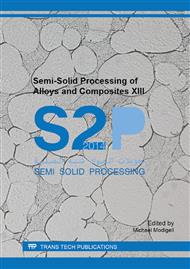[1]
M. C. Flemings, R.G. Riek, K.P. Young, Rheocasting, Mater. Sci. Eng. 25 (1976) 103–117.
Google Scholar
[2]
M.C. Flemings, Behavior of metal alloys in semisolid state, Metall. Trans. A 22(1991) 957–981.
DOI: 10.1007/bf02661090
Google Scholar
[3]
S. A. Sadough, M. R. Rahaman, and V. Pouyafar, Rheological behavior, microstructure and hardness of A356 aluminum alloy in semisolid state using backward extrusion process, J. of Trans. Nonferrous Met. Soc. China. 20 (2010) 906-910.
DOI: 10.1016/s1003-6326(10)60604-8
Google Scholar
[4]
T. Rattanochaikul, S. Janudom, N. Memongkol, and J. Wannasin, Development of aluminum rheo-extrusion process using semi-solid slurry at low solid fraction, J. of Trans. Nonferrous Met. Soc. China. 20 (2010) 1763-1768.
DOI: 10.1016/s1003-6326(09)60371-x
Google Scholar
[5]
M. R. Jafari, S. M. Zebarjad and F. Kolahan, Simulation of thixoformability of A356 aluminum alloy using finite volume method, Materials Science and Engineering. A 454–455 (2007) 558–563.
DOI: 10.1016/j.msea.2006.11.124
Google Scholar
[6]
A. Ghosh and A. K. Mallik, Manufacturing Science, 2nd Edition, East-West Private Ltd., New Delhi, (1997).
Google Scholar
[7]
N. Barman, P. Kumar and P. Dutta, J. of Materials Processing Tech., 209 (2009)5912.
Google Scholar
[8]
A. N. Alexandrou, On the Modeling of semisolid suspentions, Solid State Phenomena, 141-143 (2008) 17-23.
DOI: 10.4028/www.scientific.net/ssp.141-143.17
Google Scholar
[9]
S. Simlandi, N. Barman, and H. Chattopadhyay, Study on rheological behaviour of A356 alloy during solidification in presence of stirring, Transactions IIM. 65(6) (2012) 809-814.
DOI: 10.1007/s12666-012-0204-z
Google Scholar
[10]
S. Simlandi, N. Barman, and H. Chattopadhyay, Study of thixotropic property of A356 alloy in semisolid state, Solid State Phenomena. 192-193 (2013) 335-340.
DOI: 10.4028/www.scientific.net/ssp.192-193.335
Google Scholar
[11]
P. Das, S.K. Samanta, H. Chattopadhyay, N. Barman, N., P. Datta, Rheological characterization of semi-solid A356 aluminium alloy, Solid State Phenomena 192-193 (2013), 329-334.
DOI: 10.4028/www.scientific.net/ssp.192-193.329
Google Scholar
[12]
H. V. Atkinson, Modelling the semisolid processing of metallic alloys, Progress in Materials Science. 50 (2005) 341–412.
DOI: 10.1016/j.pmatsci.2004.04.003
Google Scholar
[13]
G. R. Burgos, N. Andreas, A. N. Alexandrou, V. Entov, Thixotropic rheology of semisolid metal suspensions, Journal of Materials Processing Technology. 110 (2001) 164-176.
DOI: 10.1016/s0924-0136(00)00731-7
Google Scholar


